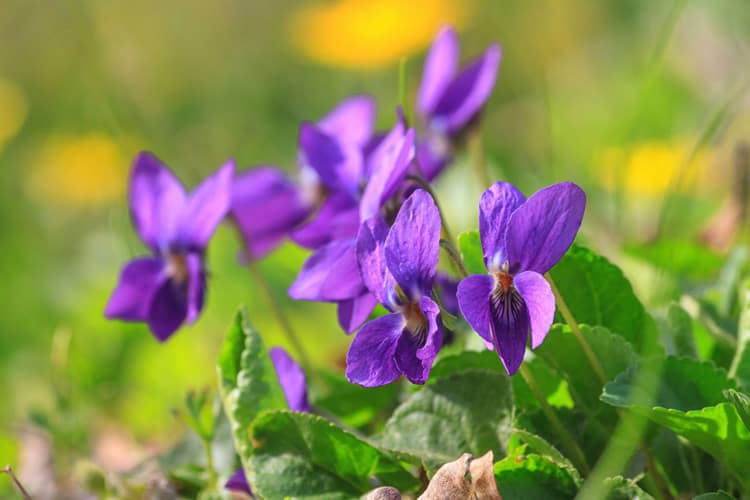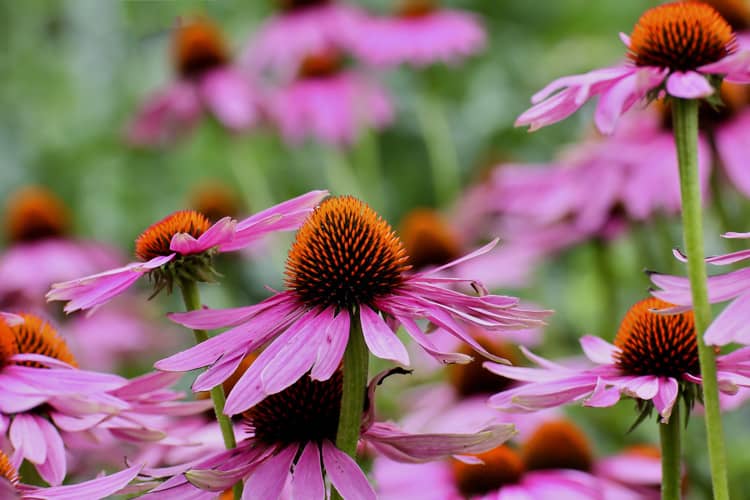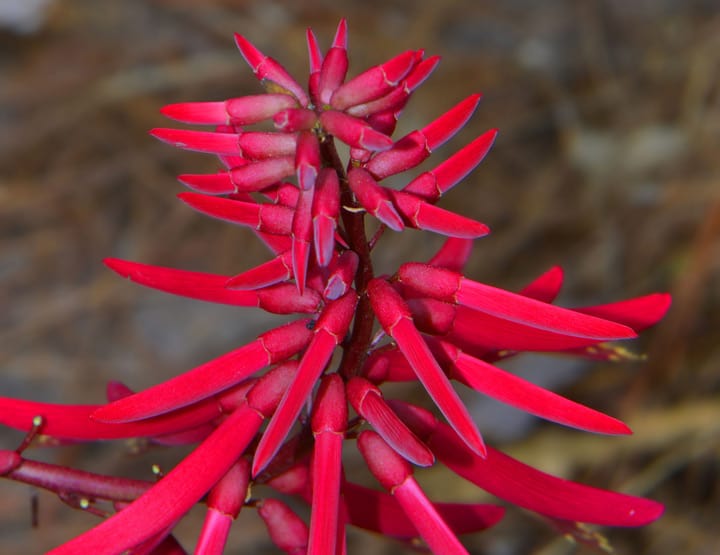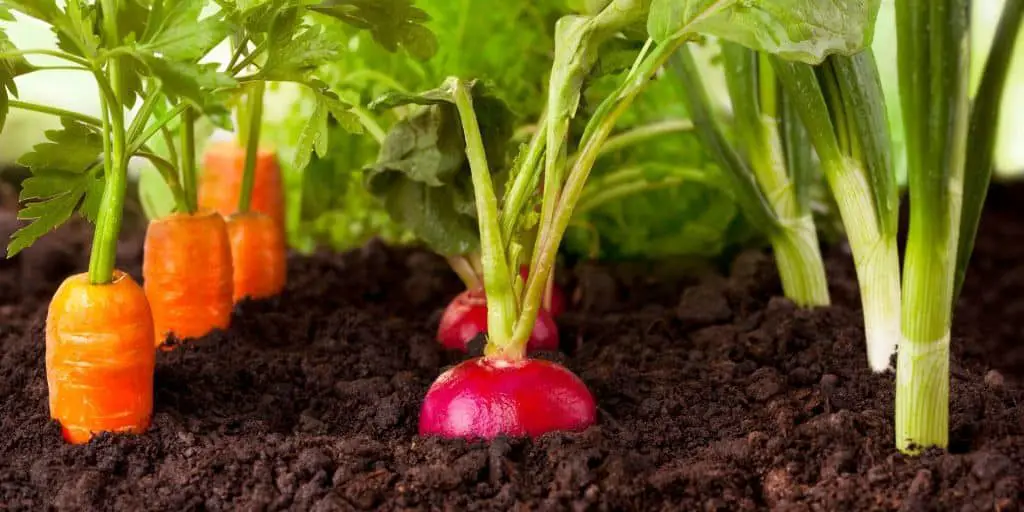
Native Florida Flowers – 12 Colorful Ideas For Your Yard
Why Use Native Florida Flowers?
Native flowers refer to flowers that existed naturally in an area before humans altered the landscape. There are many advantages to using native Florida flowers in your garden. They are suited for their environment, so they are more likely to thrive. As a result, they need less water and fertilization. Native Florida flowers also provide natural food and shelter for the native birds and other pollinators in your area. Below you’ll find some great ideas for your Florida garden including photos. If you want to learn more, be sure to visit the Florida Native Plant Society: (https://www.fnps.org/).
Native Purple Flowers in Florida
Liatris

Of all purple flowers in Florida, the liatris is the showiest. Also called blazing star and gay feather, the liatris is a striking flower in any garden. The stall upright stems range from 18 inches to 5 feet tall. The flower heads start blooming at the top of the stem and move down until all buds have blossomed. The result is a stunning purple column reminiscent of a large bottlebrush that bees and other pollinators love. They grow well in most well-drained garden soil and prefer a sunny site. They are perfect for adding drama and color to your perennial border. The liatris also works well as a cut flower. Once established, the liatris is fairly drought tolerant. There are also yellow and white varieties.
Spiderwort

The spiderwort is an upright flower that forms pretty purple flowers that have three petals. There are also white, pink, and blue varieties. They bloom from late spring to first frost. The clumps can reach 2 feet high and can look untidy in a formal garden. Therefore, spiderworts are best suited for informal and cottage gardens. They reseed easily and you are certain to find them growing in new and unexpected places in your garden.
Violet

Violets are native Florida flowers that grow wild in open woodlands and many cleared areas. There are many varieties but most grow low to the ground and self-sow easily. Purple, or some shade of purple, is most common, but white varieties are also seen. They bloom in late winter or early spring. They are beautiful in wooded gardens and rock gardens.
Native Yellow Flowers in Florida
Beach Sunflower

The beach sunflower is a pretty and tough flower shaped like a daisy that grows well in all areas of Florida except for wet sites. When one thinks of yellow flowers in Florida, this pretty yellow flower with a brown center often comes to mind. It is commonly seen growing in sandy coastal areas and, as a result, does well in sandy soil. It is great as a groundcover or in borders. They bloom year-round except during winter in some coldest portions of the state. Frost can damage plants but they grow back from the stems that are left in the ground. Once established, they are drought tolerant and need little attention.
According to the University of Florida website (visit page), there are three varieties of beach sunflower found in Florida, and care must be taken to plant the correct variety in your locale. All are found on coastal dunes.
Cucumber Dune Sunflower – Grows from 7 to 10 inches tall and is found in the northern counties of the Gulf Coast south to Desoto county.
East Coast Dune Sunflower – Grows from 4 to 10 inches along the Atlantic coast.
West Coast Dune Sunflower – Grows from 2 to 6 inches from Pinellas County south to Lee County.
Black-Eyed Susan

Easy to grow and pretty in the garden, the black-eyed Susan is a pretty orange-yellow flower with a brown center shaped like a daisy. It is salt and drought tolerant and, as a result, works great in coastal gardens. It is a great native Florida flower to use in perennial borders and butterfly gardens. They do best in a sunny well-drained location. Of all native Florida flowers, the black-eyed Susan is one of the toughest.
Coreopsis

Also called tickseed, the coreopsis is Florida’s state wildflower. These sunny yellow flowers grow from spring to fall and are commonplace along Florida’s roadsides and in many natural settings. They often reseed and are true to color. Like most wildflowers, they are drought tolerant and need minimal care. They grow from 1 to 2 feet tall and look best planted in clusters.
Swamp Sunflower

More upright than the beach sunflower, and shorter than the traditional sunflower, the swamp sunflower blooms in the fall and is a favorite of all pollinators. The blooms are a sunny yellow that makes a great splash in the fall garden. It grows best in full sun but will tolerate partial shade. Depending on the variety, they range in height between 2 and 6 feet. They look pretty planted in the back of perennial beds, and along walls and fences. They require little maintenance and are drought tolerant.
Native Pink Flowers in Florida
Purple Coneflower

While named the purple coneflower, the blossoms of this native Florida flower are actually more of a pink color. Similar in shape to a daisy, the coneflower also has yellow, white, and orange varieties, but the pinkish blooms are native to Florida. They are 1 to 2 feet tall when mature and look great in perennial borders. They tolerate most soils but do best when in rich soil. Likewise, they tolerate light shade but flower best in full sun.
Native Red Flowers in Florida
Coral Bean

The coral bean is among the most unusual of red flowers in Florida. It grows as tall as 6 feet and its red tubular flowers bloom in the spring. The pretty blooms attract bees, butterflies, and hummingbirds. In the fall, the coral bean’s seed pods mature and then split open revealing shiny scarlet seeds. The seeds are quite striking, but also very poisonous. If you have children or pets, you might want to avoid planting this particular native Florida flower. In North and Central Florida the coral bean grows as tall as 6 feet before it freezes to the ground in winter. In South Florida, the plant grows as large as a shrub or small tree. It does well in well-drained sandy soil and flowers best in full sun or light shade. It is also salt tolerant, so it works well for coastal gardens.
Scarlet Salvia

Scarlet Salvia is a perennial native to Florida that attracts bees, butterflies, and hummingbirds to it red tubular flowers. The flowers bloom from spring to fall and sometimes are also pink and white. It grows from three to four feet tall and thrives in most conditions. It looks great in perennial borders. Salvia also tends to self-sow so you might spot new plants in other areas of your garden. Once established, it is fairly drought tolerant.
Columbine

The columbine is a pretty wildflower that grows in a variety of species in most states. Every spring, the columbine produces delicate blossoms that have been compared to a ballerina and a crown. The flowers are blue, pink, white, red, and purple, depending on the variety. Also depending on the variety, they range in height from a few inches to 3 feet. In Florida, however, the native columbine is the red columbine. It grows in three counties of the Florida panhandle and the flowers are red and yellow. They grow in any fertile soil and do well in full sun or light shade. They tend to self-sow, and the resulting flowers are often not true to form. Therefore, cut down old flowering stems before they go to seed. Columbines work well in informal gardens.
Native White Flowers in Florida
Swamp Lily

Also called the string lily, the swamp lily is at home in wet areas such as along streams, swamps, and ponds. It grows 2 to 3 feet tall and has delicate spidery white fragrant blooms. It thrives in wet areas and standing water.
Local is Best
If you are planning your garden around native Florida flowers, take some time to visit your local nurseries. Reputable nurseries will be happy to guide your selection according to your zone and needs.
Related Posts
- Flowers That Attract Bees to Your Garden







